Home | Tours | Trip Reports | News | Team | Calendar | Links | Contact | Store | Mailing List

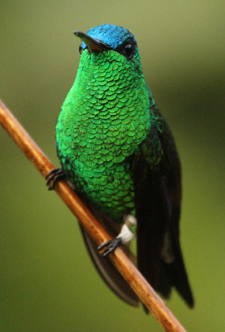 COLOMBIA
COLOMBIATRIP REPORT
November 27 - December 15, 2010
PHOTOS> TRIP REPORT> SPECIES LIST(pdf)>
Indigo-capped Hummingbird. Endemic.
Photo: Steve Bird
MAIN TOUR: 27 November – 10 December 2010
LEADERS: Diego Calderon, Gina Nichol and Steve Bird
Day 1 - November 27
The group arrived in Bogota in the evening after a long, uneventful flight from London. Diego was waiting at the hotel but all were too tired for dinner so we all settled in for the evening and had a good night’s rest before the trip got underway.
Day 2 - November 28
There was a definite air of excitement on our first morning of the trip. After an early breakfast we gathered in the hotel car park to load the bus and depart for Chingaza National Park. We ticked our first few birds here - Eared Dove, Great Thrush, and Rufous-collared Sparrow and then departed the city heading east out of Bogota toward Chingaza.
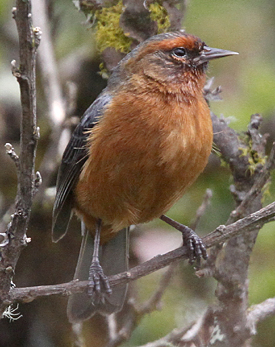 Heavy rains had deluged Colombia over the past several months causing landslides and other travel problems. This unfortunately caused other tour in lost days and endless delays. The big difference for us was that by using Colombia’s best local guide with all his connections, we were able to get to many sites others could not.
It was ironic that our first day started out clear and sunny and the weather was warmer and drier than expected. Our first birding stop offered a noisy mixed flock which created a panic as we were getting out of the van. Diego called attention to our first endemic a group of Rufous-browed Conebills (Photo: Steve Bird), soon followed by Superciliaried Hemispingus, and Black Flowerpiercer. We walked and birded slowly along a quiet road which offered many avian delights including a Red-crested Cotinga perched atop a tree, several White-throated Tyrannulets, Black-capped Tyrannulet, Buff-breasted Mountain Tanager, Tyrian Metaltail, Masked Flowerpiercer, Golden-fronted Whitestart, and Brown-backed Chat Tyrant. We had excellent views of a Glowing Puffleg and a nearby Silvery-throated Spinetail called occasionally but did not show. Some Band-tailed Pigeons were flying around as the mist began to set in. We followed the sound of an owl until we got our sights on a nice Andean Pygmy Owl which perched out in the open for several minutes allowing excellent scope views. A large hummingbird was seen further up the hill and identified as a Great Sapphirewing. The roadside shrubs yielded Slaty Brush Finch, Blue-backed Conebill, Black-crested Warbler, and Sparkling and Green Violetear. A Crowned Chat Tyrant popped into view and sat perched in thick vegetation fairly close allowing close scrutiny of this usually difficult to see bird.
Heavy rains had deluged Colombia over the past several months causing landslides and other travel problems. This unfortunately caused other tour in lost days and endless delays. The big difference for us was that by using Colombia’s best local guide with all his connections, we were able to get to many sites others could not.
It was ironic that our first day started out clear and sunny and the weather was warmer and drier than expected. Our first birding stop offered a noisy mixed flock which created a panic as we were getting out of the van. Diego called attention to our first endemic a group of Rufous-browed Conebills (Photo: Steve Bird), soon followed by Superciliaried Hemispingus, and Black Flowerpiercer. We walked and birded slowly along a quiet road which offered many avian delights including a Red-crested Cotinga perched atop a tree, several White-throated Tyrannulets, Black-capped Tyrannulet, Buff-breasted Mountain Tanager, Tyrian Metaltail, Masked Flowerpiercer, Golden-fronted Whitestart, and Brown-backed Chat Tyrant. We had excellent views of a Glowing Puffleg and a nearby Silvery-throated Spinetail called occasionally but did not show. Some Band-tailed Pigeons were flying around as the mist began to set in. We followed the sound of an owl until we got our sights on a nice Andean Pygmy Owl which perched out in the open for several minutes allowing excellent scope views. A large hummingbird was seen further up the hill and identified as a Great Sapphirewing. The roadside shrubs yielded Slaty Brush Finch, Blue-backed Conebill, Black-crested Warbler, and Sparkling and Green Violetear. A Crowned Chat Tyrant popped into view and sat perched in thick vegetation fairly close allowing close scrutiny of this usually difficult to see bird.
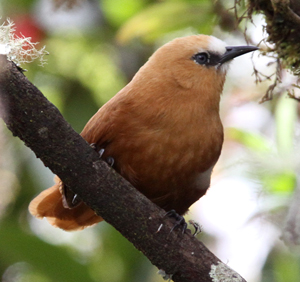 At the peak, we enjoyed a short coffee break and snacks but the birds beckoned us on and a superb adult Bronze-tailed Thornbill was eventually seen by all, later followed by a couple of immature birds. A band of handsome Rufous Wrens (Photo: Steve Bird) worked along the hillside and we had three species of Flowerpiercer here - Black, Masked, and White-sided.
At the peak, we enjoyed a short coffee break and snacks but the birds beckoned us on and a superb adult Bronze-tailed Thornbill was eventually seen by all, later followed by a couple of immature birds. A band of handsome Rufous Wrens (Photo: Steve Bird) worked along the hillside and we had three species of Flowerpiercer here - Black, Masked, and White-sided.
We moved on to our next site which was a wetland area surrounded by farm fields. We squeezed through the fence and walked slowly and systematically toward the reeds in the hopes of spotting a Bogota Rail. In the open water of a small pond there were Spot-flanked Gallinule, Andean Teal, American Coot, Andean Duck, and Pied-billed Grebe. A few Eastern Meadowlarks were singing and showing well in the grasses. Suddenly, a Bogota Rail scurried across an open area not far from us and soon we had decent views of at least three of this Colombian endemic.
During lunch at a nearby restaurant, we kept watch on a large kettle of Black Vultures swirling over a distant hill. Across the road from the restaurant there was a large white flowering bush which was attracting Eastern Kingbirds, a Tropical Kingbird, and at least one Tropical Mockingbird to feed on the flowers. The hirundines flying in the distance were soon identified as Brown-bellied Swallows.
Our next birding site was inaccessible due to a landslide so an itinerary change took us back through Bogota. Along the way we picked up Great Egret, many Cattle Egrets, and our first White-tailed Kite. As we entered the city, a Peregrine Falcon was seen flying around some tall 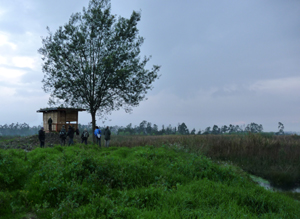 buildings. The sky had now turned pink and gray in the afternoon light which was fading fast. Rain began to fall as we arrived at La Florida Park (Photo: Gina Nichol). Diego convinced a ranger to let us access the marsh area where we saw Black-crowned Night Heron and a female Yellow-hooded Blackbird. An Apolinar’s Wren called in the distance and moved toward us in the fading light but did not offer tickable views. As darkness fell, we worked our way back to the van and returned to the hotel in Bogota. La Florida Park seems to be on a lot of itineraries as a place to look for the Apolinar’s Wren and Bogota Rail, but it should really only be a back-up site as it is over-taped and the birds are very difficult. Unfortunately, due to the landslide we had to use it as a backup. Fortunately, at least we got our Bogota Rails at an alternate site. Later in the evening, we enjoyed a nice dinner in a restaurant that was a short walk from the hotel, ending our first spectacular day in the world’s Number one country for birding – Viva Colombia!
buildings. The sky had now turned pink and gray in the afternoon light which was fading fast. Rain began to fall as we arrived at La Florida Park (Photo: Gina Nichol). Diego convinced a ranger to let us access the marsh area where we saw Black-crowned Night Heron and a female Yellow-hooded Blackbird. An Apolinar’s Wren called in the distance and moved toward us in the fading light but did not offer tickable views. As darkness fell, we worked our way back to the van and returned to the hotel in Bogota. La Florida Park seems to be on a lot of itineraries as a place to look for the Apolinar’s Wren and Bogota Rail, but it should really only be a back-up site as it is over-taped and the birds are very difficult. Unfortunately, due to the landslide we had to use it as a backup. Fortunately, at least we got our Bogota Rails at an alternate site. Later in the evening, we enjoyed a nice dinner in a restaurant that was a short walk from the hotel, ending our first spectacular day in the world’s Number one country for birding – Viva Colombia!
Day 3 - November 29
Early this morning, we headed west out of Bogota for Laguna Pedro Palo at 2,000 meters in the sub-Andean forest belt on the western slope of the eastern Andes. Our first birding stop along the road leading into Pedro Palo was quite productive offering many Blackburnian Warblers, Bananaquits, numerous near endemic Scrub Tanagers, Tennessee Warbler, Summer Tanager, Booted Racket-tail, Rusty Flowerpiercer, Shiny Cowbird, Blue-gray Tanager, Blue-necked Tanager, and a nice male Gorgeted Woodstar. We birded in the mist picking up Golden-faced Tyrannulet, Red-crowned Woodpecker, Crimson-backed Tanagers, and Bay-headed Tanagers. We had excellent views of the near endemic Ash-browed Spinetail, White-vented Plumeleteer, several female Rose-breasted Grosbeaks, Brown-capped Vireo, Fawn-breasted Tanager, Lemon-rumped Tanager, Yellow-bellied Elaenia, and Great Kiskadee. We walked past a house where a Black Phoebe posed on a (decorative) heron. A Blue-tailed Emerald showed well on a perch and then hovered to feed on a flower. As we walked along the quiet road, we added Rufous-browed Peppershrike, Streaked Saltator, Squirrel Cuckoo, Sooty-headed Tyrannulet, several Black-billed Thrushes, and on one corner we had good views of a band of Moustached Brush Finches, a near endemic that is very restricted and just creeps into Venezuela.
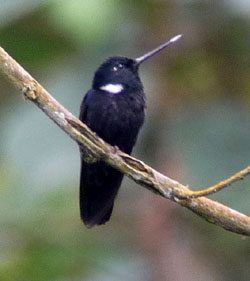 We moved up the road in the bus and at the next stop we had our first Slate-throated Whitestart, Plain Antvireo, Brown-capped Vireo, and Southern House Wren. Mick made friends with a gorgeous butterfly that attached itself to his boot hitching a ride as we walked further on. Some Acorn Woodpeckers were seen high in a tall tree and a Golden-olive Woodpecker was heard calling. A Smoky Brown Woodpecker was then seen as was a female Black-capped Tanager. Suddenly an endemic Black Inca (Photo: Gina Nichol) caught our attention as it perched right out in the open on a branch over the road ahead. The bird sat for awhile and then fed on some red flowers. As we enjoyed a coffee break, the bird returned to the perch and the flowers much to the delight of the photographers in the group. As we finished our break, an Andean Toucanet appeared in the branches just above us.
We moved up the road in the bus and at the next stop we had our first Slate-throated Whitestart, Plain Antvireo, Brown-capped Vireo, and Southern House Wren. Mick made friends with a gorgeous butterfly that attached itself to his boot hitching a ride as we walked further on. Some Acorn Woodpeckers were seen high in a tall tree and a Golden-olive Woodpecker was heard calling. A Smoky Brown Woodpecker was then seen as was a female Black-capped Tanager. Suddenly an endemic Black Inca (Photo: Gina Nichol) caught our attention as it perched right out in the open on a branch over the road ahead. The bird sat for awhile and then fed on some red flowers. As we enjoyed a coffee break, the bird returned to the perch and the flowers much to the delight of the photographers in the group. As we finished our break, an Andean Toucanet appeared in the branches just above us.
We continued walking the road adding Canada Warbler, Swainson’s Thrush, and Streaked Saltator to our ever growing day list. Next up was a superb Moustached Puffbird that appeared on a close perch where we had to maneuver to get a good view through the thick brush. We enjoyed much better views of several Acorn Woodpeckers that came down and flitted around a line of fence posts giving us an entertaining show. Our next challenge was trying to get decent views of a skulky Speckle-breasted Wren (Colombian Wren) that moved up a thick, dark tangle.
We reached an open area that looked out over a glistening lake surrounded by trees. Scanning the trees, Gina found our main target, a superb male and also a not so stunning female Turquoise Dacnis, a species that it getting very difficult to find. We enjoyed distant but good scope views. We hoped to see the bird a little closer so continued to scan a tree full of tanagers which included – Bay-headed, Palm, Blue-gray, and Black-capped, all feeding on the tree’s fruits. An Osprey was  seen flying over the lake and a perched Great Blue Heron was scoped across the far side. We also enjoyed the antics of a Hoffmann’s Two-toed Sloth (Photo: Gina Nichol) which had worked its way out to the end of a tree branch and hung precariously as it stretched to reach the leaves on an adjacent tree.
seen flying over the lake and a perched Great Blue Heron was scoped across the far side. We also enjoyed the antics of a Hoffmann’s Two-toed Sloth (Photo: Gina Nichol) which had worked its way out to the end of a tree branch and hung precariously as it stretched to reach the leaves on an adjacent tree.
We walked back down toward the van encountering another flock which included more of what we had already seen as well as Streak-necked Flycatcher and Mountain Elaenia. A bird working a high, thick tangle finally revealed itself as a male Uniform Antshrike.
We enjoyed lunch at a restaurant with a bird table stocked with bananas that attracted Blue-gray and Crimson-backed Tanagers, Thick-billed Euphonia, Black-billed Thrush, and Palm Tanager. Tropical Parula was also seen in the forest behind the feeder and there were several brilliant Saffron Finches on the ground near the restaurant. After lunch, we drive down the western slope of the eastern Andes into the Magdalena Valley. In the lowlands, the sky was a crystal clear blue and as we traveled we saw Bare-faced Ibis, Southern Lapwing, Great Egret, Roadside Hawk, and American Kestrel. At a comfort stop we picked up Vermilion Flycatcher and Eared Dove. We then crossed the Magdalena River and drove to our last stop of the day which was along a road next to some lowland fields. The trees along the road held Tropical Gnatcatcher and Yellow Warbler and there were Yellow-headed Caracaras and Blue-black Grassquits around. Three Crested Bobwhites appeared on verge and then disappeared just as quickly. A Pale-breasted Spinetail was highly elusive remaining just low enough in the grass to avoid showing well. Our accommodation for the night was in the bustling city of Ibague.
Day 4 - November 30
 This morning we made an early (now usual) departure to Combeima Canyon, a deep cut gorge on the on the eastern slope of the western Andes in the Tolima department of Colombia. We began our birding day walking a road next to a river that had cut a deep, scenic valley. There were Black Phoebes around and we had good views of Wedge-billed Hummingbird, White-capped Dipper, Torrent Tyrannulet, Blue-tailed Emerald, Slaty-backed Chat Tyrant, Streaked Saltator, and Canada Warbler, as well as nice looks at Band-tailed Pigeons perched atop distant trees.
This morning we made an early (now usual) departure to Combeima Canyon, a deep cut gorge on the on the eastern slope of the western Andes in the Tolima department of Colombia. We began our birding day walking a road next to a river that had cut a deep, scenic valley. There were Black Phoebes around and we had good views of Wedge-billed Hummingbird, White-capped Dipper, Torrent Tyrannulet, Blue-tailed Emerald, Slaty-backed Chat Tyrant, Streaked Saltator, and Canada Warbler, as well as nice looks at Band-tailed Pigeons perched atop distant trees.
We enjoyed breakfast on the veranda (Photo: Gina Nichol) overlooking the river and were soon out on the road again looking at Golden Tanager, Scrub Tanager, and Hepatic Tanager. Looking down the bank, we found two Whiskered Wrens and as we walked up the other side we found two of our endemic targets - Yellow-throated Brush Finch and the much rarer and very restricted range Yellow-headed Brush Finch. An Olivaceous Piculet did not get its deserved attention having appeared while the endemics were on show. As we continued on we noted several Blue-and-White Swallows flying around and a few Yellow-faced Grassquits. Looking over a bank toward the river, there was a small tree of life which held Blue-capped Tanager, Saffron-crowned Tanager, Tropical Parula, Black-capped Tanager, and a couple of Golden-crowned Flycatchers. An Andean Emerald posed for a long time on a branch allowing good scope views and a Black-winged Saltator distracted us as it fed on a fruiting tree much closer.
We continued up the hill to 2100 meters picking up Green Jay, Common Bush Tanagers, Azara’s Spinetail, and a nice Speckled Hummingbird feeding on an orange flower. Two Colombian Chachalacas were seen and we had a fleeting glimpse of a Yellow-billed Cacique that emerged from the bamboo and crossed the road behind us. We moved on further, right up to the top of 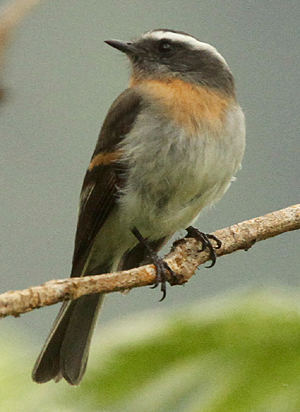 Nevada Tolima and looked out into some open fields where there were two Broad-winged Hawks perched on tree tops calling to each other. Around the car park, we found a Buff-tailed Coronet on a nest. Some stunning Blue-and-black Tanagers were seen as was a Beryl-spangled Tanager that had tucked itself into a tangle. A Saffron-crowned Tanager showed well as did a Streak-necked Flycatcher but the glamour bird of the day was a gorgeous Long-tailed Sylph that flew in and fed on some nearby flowers. Above us, a few White-tipped Swifts and Brown-bellied Swallows were noted.
Nevada Tolima and looked out into some open fields where there were two Broad-winged Hawks perched on tree tops calling to each other. Around the car park, we found a Buff-tailed Coronet on a nest. Some stunning Blue-and-black Tanagers were seen as was a Beryl-spangled Tanager that had tucked itself into a tangle. A Saffron-crowned Tanager showed well as did a Streak-necked Flycatcher but the glamour bird of the day was a gorgeous Long-tailed Sylph that flew in and fed on some nearby flowers. Above us, a few White-tipped Swifts and Brown-bellied Swallows were noted.
We walked out into the fields and scanned the trees finding a few Tourmaline Sunangels. To our delight a couple of stunning Red-hooded Tanagers was seen in the trees on the next hill. We got good views and then walked over a stream and up a steep hill to an open area closer to where the birds were seen. The scenery was stunning and here we found Mountain Cacique, Lacrimose Mountain Tanager, two Rufous-breasted Chat Tyrants (Photo: Steve Bird) and got more views of Red-hooded Tanager – one of Steve’s birds of the trip. From here we crossed the Cauca Valley on our way to the city of Cartago putting us in position to bird the eastern slope of the western Andes the next day.
Day 5 - December 1
We departed Cartago very early this morning traveling west to Altos Galapagos on the eastern slope of the western Andes. Just before the entrance there was a large landslide which had made the road impassable so we got out and walked across in near knee-deep mud to meet our 4-wheel drive jeeps at the entrance of the famous Galapagos Road. Our friend Johnnier was there to greet us and we drove up the road in a convoy stopping at a stream on the corner. This was to be our breakfast spot but we were soon off seeing Golden Tanager, Golden-hooded Tanager, Greenish Puffleg and a group of endemic Crested Ant-tanagers that showed amazingly well. In fact, these were the best views Gina and Steve have ever had of this skulky bird. Green Hermit, 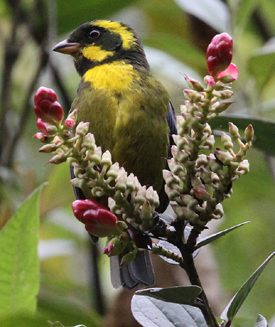 Montane Foliage-gleaner, Spotted Barbtail and a brief Slaty Antwren were all seen before we were summoned back to the jeeps for breakfast. The weather was perfect, cool, overcast, and no wind and we were treated to an excellent field breakfast using our Willy jeeps as picnic tables. After breakfast we continued walking the road. An Andean Solitaire and several other scolding birds drew our attention to a Mottled Owl that was being mobbed by birds. Roger picked it out and we soon had it in the scope.
Montane Foliage-gleaner, Spotted Barbtail and a brief Slaty Antwren were all seen before we were summoned back to the jeeps for breakfast. The weather was perfect, cool, overcast, and no wind and we were treated to an excellent field breakfast using our Willy jeeps as picnic tables. After breakfast we continued walking the road. An Andean Solitaire and several other scolding birds drew our attention to a Mottled Owl that was being mobbed by birds. Roger picked it out and we soon had it in the scope.
Continuing along the road we also had Golden-winged Warbler, a Rufous-breasted Flycatcher calling, Speckled Hummingbird, Violet-tailed Sylph, Broad-winged Hawk, Bronzy Inca, and an excellent endemic Munchique Wood-wren – differentiated from Gray-breasted by vocalization and streaks on the throat and a narrower supercilium. Our first Gold-ringed Tanager (Photo: Steve Bird) was a vision and we soon realized that this endemic was a common bird here and we saw at least a dozen or more by the end of the day. We stopped at a pump house along the road to see the Green-fronted Lancebill nests that were attached to it. There was one bird in attendance and it showed well, albeit briefly as it perched on a low branch behind the house. Also in the area were Velvet-purple Coronet, Purplish-mantled Tanager , Glistening Green Tanager , and Gray-breasted Wood Wren. A Tawny-bellied Hermit caught our attention as it flitted around a tangle below a fruiting tree. To our surprise, an Olivaceous Piha (Choco endemic) appeared in the tree and showed incredibly well. A few minutes later, a stunning Orange-breasted Fruiteater (Choco endemic) joined it on the fruiting tree. Wow – what a tree! Two Grass-green Tanagers drew our attention to the other side of the road and then panic ensued as we spotted a Fulvous-dotted Treerunner in the vegetation below. Several Dusky-headed Bush-Tanagers appeared and as if it wasn’t colorful enough, a striking Green-and-black Fruiteater appeared in the fruiting tree, beside the Orange-breasted and the Piha!
When we finished with this spectacle a Cinnamon Flycatcher showed well across the road. A Brown Inca was also seen (Choco endemic) and we had good views of a Nariño Tapaculo. Continuing on we had a group of Tricolored Brush Finches, and a female Empress Brilliant. We enjoyed a picnic lunch at the peak and then crossed over to the western slope of the western Andes into the Choco region. It started to rain but we pushed on earning good views of Velvet-purple Coronet, Pearled Treerunner, Buffy (Pacific) Tuftedcheek, more Purplish-mantled Tanagers, amazing views and photos of Fulvous-dotted Treerunner, Three-striped Warbler, and Slaty-backed Chat Tyrant. The rain got heavier and we decided to head back to El Cairo for the night enjoying a nice dinner and a look at the incredible moths that were being attracted to the restaurant and hotel lights.
Day 6 - December 2
We departed El Cairo before dawn to get to Altos Galapagos early this morning. This time, we traveled to the top and over the peak into the Choco department to bird the western slope of the western Andes. Heavy rain overnight had made for muddy and wet conditions and as we approached our first stop, we notice several black birds jumping out of our way on the road. They turned out to be Black Solitaires coming out to the open road presumably to pick up grit. It was an unprecedented show by a normally very skulky species and we must have seen at least six birds. As the drivers set up our field breakfast in the old school, we found Chestnut-breasted Chlorophonias in a tree along the road and picked up Cinnamon Flycatcher, Purplish-mantled Tanager, and White-collared Swift.
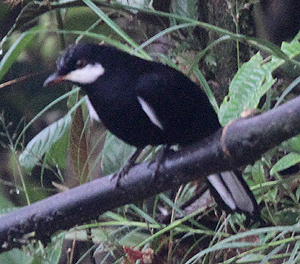 During breakfast, we worked our way around to the back of the school which was quite birdy offering Velvet-purple Coronet, another Chestnut-breasted Chlorophonia, Tricolored Brush Finch, and Gray-breasted Wood Wren. After breakfast, we birded along the road picking up Golden Tanager, more Black Solitaires (Photo: Steve Bird), Collared Trogon, and Brown Inca. Further down, we spent some time birding by a bridge and found Lemon-rumped Tanager, Silver-throated Tanager, Sickle-winged Guan, Rufous-throated Tanager, Orange-bellied Euphonia, and a female Green Honeycreeper. There were a few White-tailed Hillstar around and a female Green-crowned Woodnymph. We marveled at the Leaf Cutter Ants carrying leaf parts in a steady stream along both sides of the bridge. We continued up the hill from the bridge stopping at one corner to see a Red-headed Barbet, a Dwarf Squirrel, Ornate Flycatcher, Streak-necked Flycatcher, and a female Golden-winged Manakin. All at once a Common Opossum emerged from the bank and began walking up the road ahead of us – seemingly unaware of the fact that we were there. We watched it saunter up the middle of the road, until we heard a huge Chiva coming. Diego ran up and coaxed it off the road rescuing it from a certain flattening!
During breakfast, we worked our way around to the back of the school which was quite birdy offering Velvet-purple Coronet, another Chestnut-breasted Chlorophonia, Tricolored Brush Finch, and Gray-breasted Wood Wren. After breakfast, we birded along the road picking up Golden Tanager, more Black Solitaires (Photo: Steve Bird), Collared Trogon, and Brown Inca. Further down, we spent some time birding by a bridge and found Lemon-rumped Tanager, Silver-throated Tanager, Sickle-winged Guan, Rufous-throated Tanager, Orange-bellied Euphonia, and a female Green Honeycreeper. There were a few White-tailed Hillstar around and a female Green-crowned Woodnymph. We marveled at the Leaf Cutter Ants carrying leaf parts in a steady stream along both sides of the bridge. We continued up the hill from the bridge stopping at one corner to see a Red-headed Barbet, a Dwarf Squirrel, Ornate Flycatcher, Streak-necked Flycatcher, and a female Golden-winged Manakin. All at once a Common Opossum emerged from the bank and began walking up the road ahead of us – seemingly unaware of the fact that we were there. We watched it saunter up the middle of the road, until we heard a huge Chiva coming. Diego ran up and coaxed it off the road rescuing it from a certain flattening!
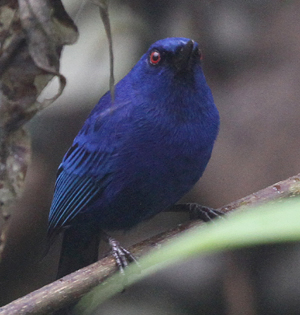 Birding continued with another look at Munchique Wood Wren, a nice male Violet-tailed Sylph perched and then feeding on flowers, Rusty-margined Flycatcher, a Gray-rumped Swift that zoomed through quickly, Swallow-tailed Kites, Smoke-colored Pewee, Southern Rough-winged Swallow, and a female Yellow-bellied Seedeater. We then crossed paths with a dazzling Indigo Flowerpiercer (Photo: Steve Bird) showing stunning color and it was a delight to see this bird so closely and so well. A pair of Yellow-breasted Antwrens soon diverted attention from the blue beauty as this may be the only confirmed record of this species from Galapagos Road.
Birding continued with another look at Munchique Wood Wren, a nice male Violet-tailed Sylph perched and then feeding on flowers, Rusty-margined Flycatcher, a Gray-rumped Swift that zoomed through quickly, Swallow-tailed Kites, Smoke-colored Pewee, Southern Rough-winged Swallow, and a female Yellow-bellied Seedeater. We then crossed paths with a dazzling Indigo Flowerpiercer (Photo: Steve Bird) showing stunning color and it was a delight to see this bird so closely and so well. A pair of Yellow-breasted Antwrens soon diverted attention from the blue beauty as this may be the only confirmed record of this species from Galapagos Road.
It began raining heavily so we decided to make our way back up to the peak. We reached an area where some motor bikes had stopped to assess a new landslide in the road but our Willy jeeps forged through getting us safely to the other side before the road became impassable. Up at the top, it was still raining heavily so we decided to continue on slogging through the deep mud that was getting deeper by the minute.
Down on the main road, we saw a line of vehicles waiting to pass the original landslide that we had walked across yesterday. We walked up to assess the situation and decided to cross it on foot to get to Lucas and our van waiting on the other side.
We were soon on our way back toward the Cauca Valley and the Central Andes. A roadside stop for a drink and rest break yielded several birds in the cow fields across the street including Vermilion Flycatcher, Southern Lapwing, Northern Caracara, Yellow-headed Caracara, Blue-headed Parrots, Black-throated Mango, and Blue-gray Tanager. Later on, we arrived at our accommodation just outside the Otun Quimbaya reserve in the foothills of the central Andes.
Day 7 - December 3
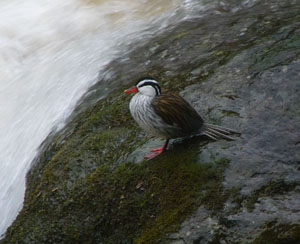 We arrived at Otun Quimbaya Reserve in the rain but that didn’t stop us and while enjoying a fresh mug of coffee, we were soon watching our first Red-ruffed Fruitcrows in the gardens of the reserve buildings. We trained our scopes on the five Cauca Guans roosting in a tree and invited the birders that were with another group to enjoy the view. The lodge roof shielded us from the rain while we birded the gardens picking up Flame-rumped Tanager, Black-and-white Warbler, Canada Warbler, and Highland Motmot. The rain subsided a little and we began walking up the road adding more Red-ruffed Fruitcrows and Cauca Guans. A short trail led to an overlook where a raging river played host to a pair of Torrent Ducks (Photo: Gina Nichol) perched on one of the few exposed rocks. A White-capped Dipper flew in and tried to land on the same rock but the female Torrent Duck chased it off. Back out on the road, we saw Inca Jays, a male Booted Racket-tail and a flock of warblers that included Golden-winged, Tropical Parula, Black-and-White, Canada. The same flock included two beautiful endemic Multicolored Tanagers - male and female! We watched these
We arrived at Otun Quimbaya Reserve in the rain but that didn’t stop us and while enjoying a fresh mug of coffee, we were soon watching our first Red-ruffed Fruitcrows in the gardens of the reserve buildings. We trained our scopes on the five Cauca Guans roosting in a tree and invited the birders that were with another group to enjoy the view. The lodge roof shielded us from the rain while we birded the gardens picking up Flame-rumped Tanager, Black-and-white Warbler, Canada Warbler, and Highland Motmot. The rain subsided a little and we began walking up the road adding more Red-ruffed Fruitcrows and Cauca Guans. A short trail led to an overlook where a raging river played host to a pair of Torrent Ducks (Photo: Gina Nichol) perched on one of the few exposed rocks. A White-capped Dipper flew in and tried to land on the same rock but the female Torrent Duck chased it off. Back out on the road, we saw Inca Jays, a male Booted Racket-tail and a flock of warblers that included Golden-winged, Tropical Parula, Black-and-White, Canada. The same flock included two beautiful endemic Multicolored Tanagers - male and female! We watched these 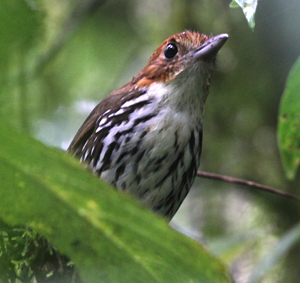 beauties for awhile until a troop of Venezuelan Red Howler Monkeys caught our attention on the other side of the road. Other birds here included Fawn-breasted Tanager, White-winged Becard, Squirrel Cuckoo, Black-billed Peppershrike, Greenish Puffleg, and Bronzy Inca. As we worked our way back along the road, we encountered a small, frenetic flock that contained Marble-faced and Variegated Bristle Tyrants, Montane Woodcreeper, Crested Ant-tanager, Rufous-breasted Flycatcher, and Acadian Flycatcher. During our picnic lunch on the road, a pair of inquisitive Chestnut-crowned Antpittas (Photo: Steve Bird) appeared right next to us in the forest as if to check us out.
beauties for awhile until a troop of Venezuelan Red Howler Monkeys caught our attention on the other side of the road. Other birds here included Fawn-breasted Tanager, White-winged Becard, Squirrel Cuckoo, Black-billed Peppershrike, Greenish Puffleg, and Bronzy Inca. As we worked our way back along the road, we encountered a small, frenetic flock that contained Marble-faced and Variegated Bristle Tyrants, Montane Woodcreeper, Crested Ant-tanager, Rufous-breasted Flycatcher, and Acadian Flycatcher. During our picnic lunch on the road, a pair of inquisitive Chestnut-crowned Antpittas (Photo: Steve Bird) appeared right next to us in the forest as if to check us out.
After lunch, we continued driving out the entrance road and in the agricultural areas we saw Yellow-faced Grassquit, Yellow-bellied Seedeater, Roadside Hawk, and Saffron Finch. At one point, we could see the river from the road and noted two more Torrent Ducks on the rocks and a Spotted Sandpiper. We continued on to the city of Manizales, the main center for the production of Colombian coffee. We checked into the hotel and soon met up again to walk up to an area behind the hotel that contained hummingbird feeders. The feeders hosted Collared Inca, Buff-tailed Coronet, White-bellied Woodstar, Bronzy Inca, Long-tailed Sylph, Green Violetear, 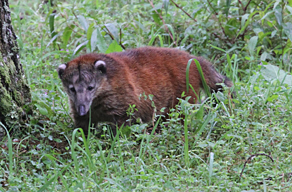 Sparkling Violetear, Rufous-tailed Hummingbird, White-sided Flowerpiercer, and Steely-vented Hummingbird and as we watched this hive of activity cameras clicked merrily away. There was also a very wet Highland Motmot posing for photos. Beyond the feeders, Steve spotted an animal foraging on the ground. It turned out to be a very busy Mountain Coati (Photo: Steve Bird) digging holes in search of food. The Coati entertained us for several minutes seemingly unconcerned with our presence.
Sparkling Violetear, Rufous-tailed Hummingbird, White-sided Flowerpiercer, and Steely-vented Hummingbird and as we watched this hive of activity cameras clicked merrily away. There was also a very wet Highland Motmot posing for photos. Beyond the feeders, Steve spotted an animal foraging on the ground. It turned out to be a very busy Mountain Coati (Photo: Steve Bird) digging holes in search of food. The Coati entertained us for several minutes seemingly unconcerned with our presence.
On our way back we checked the area by the chairlift (which brings visitors up from the town) and found Masked and Bluish Flowerpiercers. Three Great Blue Herons were seen perched on top of some evergreens and as it was getting dark we made our way back to the hotel. In the evening after dinner, we went out to check a spot for White-throated Screech Owl. The continued rain made it difficult to hear but a bird was calling nearby but never showed. There was also a Rufous-banded Owl heard calling a little further away.
Day 8 - December 4
Today we spent the day at Rio Blanco Reserve on the western slope of the central Andes. Along the way we forged the two rivers that flow over the road that lead up to the reserve and as we arrived the feeders on the porch were buzzing with Buff-tailed Coronets. After breakfast at the lodge, we gathered just outside to witness our first mixed feeding flock in the nearby trees which included Capped Conebill, Gray-hooded Bush Tanager, Blue-winged Mountain Tanager, Blue-and-black Tanager, Black-eared Hemispingus, Golden-faced Redstart, Superciliaried Hemispingus, Golden-winged Warbler, Barred Becard, and a group of Rusty-faced Parrots 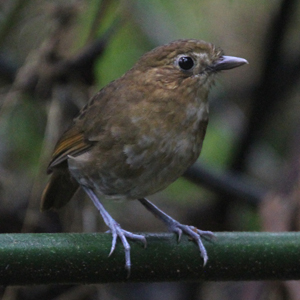 that passed quickly overhead. We began walking up the road and soon hit the same flock moving up with us. We enjoyed fabulous views and added Pearled Treerunner and Black-headed Hemispingus. Our first stop was the reserve’s Antpitta feeding station. Before the worm man even stepped away from the feeding area, the endemic Brown-banded Antpitta (Photo: Steve Bird) was picking at the worms. We also had excellent views of Chestnut-crowned Antpitta and to our surprise another Brown-banded Antpitta came out of the forest right next to us – two feet away! A Black-billed Mountain Toucan tore us away from the antpittas and we soon continued up the road adding Grass-green Tanager, Montane Woodcreeper, Rufous-crowned Tody-Tyrant, several Plushcaps, Black-capped Hemispingus, Buff-breasted Mountain Tanager, Ash-colored Tapaculo and Long-tailed Antbird, a bamboo specialist. There was a Blackish Tapaculo calling and some nearby Sharpe’s Wrens were seen as well as Yellow-billed Cacique and Mountain Wren. It started to rain but we pushed on hoping to catch the Bicolored Antpitta that was calling. A Black-crested Warbler gave good views as did a Pale-edged Flycatcher.
that passed quickly overhead. We began walking up the road and soon hit the same flock moving up with us. We enjoyed fabulous views and added Pearled Treerunner and Black-headed Hemispingus. Our first stop was the reserve’s Antpitta feeding station. Before the worm man even stepped away from the feeding area, the endemic Brown-banded Antpitta (Photo: Steve Bird) was picking at the worms. We also had excellent views of Chestnut-crowned Antpitta and to our surprise another Brown-banded Antpitta came out of the forest right next to us – two feet away! A Black-billed Mountain Toucan tore us away from the antpittas and we soon continued up the road adding Grass-green Tanager, Montane Woodcreeper, Rufous-crowned Tody-Tyrant, several Plushcaps, Black-capped Hemispingus, Buff-breasted Mountain Tanager, Ash-colored Tapaculo and Long-tailed Antbird, a bamboo specialist. There was a Blackish Tapaculo calling and some nearby Sharpe’s Wrens were seen as well as Yellow-billed Cacique and Mountain Wren. It started to rain but we pushed on hoping to catch the Bicolored Antpitta that was calling. A Black-crested Warbler gave good views as did a Pale-edged Flycatcher.
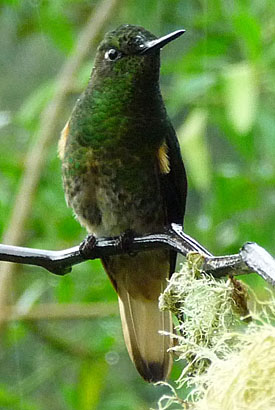 During lunch, we enjoyed watching the feeders and the antics of many Buff-tailed Coronets (Photo: Gina Nichol), a few Tourmaline Sunangels, and a several Fawn-breasted Brilliants. Rain continued and we walked back up the hill picking up more birds including Streaked Xenops, Golden-fronted Redstart, Olive-sided Flycatcher, Black-capped Tyrannulet, Blue-capped Tanager, Smoky Bush Tyrant, and a superb Masked Saltator spotted by Roger. Diego relayed a story about Colombian jumping worms as we took another trail up to the right. As we entered a gated area, a Sickle-winged Guan was spotted moving in a tree, as we heard an Ocellated Tapaculo which eventually allowed varying views and glimpses through the thick bamboo. Much better were our views of a pair of Chestnut-capped Brush Finches out on the open path. We also saw Gray-breasted Wood Wren, another Dwarf Squirrel, Pale-edged Flycatcher, and got quick views of more Rusty-faced Parrots flying over.
During lunch, we enjoyed watching the feeders and the antics of many Buff-tailed Coronets (Photo: Gina Nichol), a few Tourmaline Sunangels, and a several Fawn-breasted Brilliants. Rain continued and we walked back up the hill picking up more birds including Streaked Xenops, Golden-fronted Redstart, Olive-sided Flycatcher, Black-capped Tyrannulet, Blue-capped Tanager, Smoky Bush Tyrant, and a superb Masked Saltator spotted by Roger. Diego relayed a story about Colombian jumping worms as we took another trail up to the right. As we entered a gated area, a Sickle-winged Guan was spotted moving in a tree, as we heard an Ocellated Tapaculo which eventually allowed varying views and glimpses through the thick bamboo. Much better were our views of a pair of Chestnut-capped Brush Finches out on the open path. We also saw Gray-breasted Wood Wren, another Dwarf Squirrel, Pale-edged Flycatcher, and got quick views of more Rusty-faced Parrots flying over.
Day 9 - December 5
Today we had to alter our itinerary slightly because a major landslide closed access to Los Nevados National Park indefinitely. The change proved productive with a great morning of birding at a small park in Manizales which was quite birdy and offered a few surprises. As we arrived and entered the park, several Bay-headed Tanagers were seen in the Cecropia trees. A brightly colored Crimson-rumped Toucanet showed well overlooking an open area with a small stream, and we also had Band-tailed Pigeon, Slate-throated Redstart, and Canada Warbler from that vantage point. There were several Swainson’s Thrushes around as well as Flame-rumped Tanager, Palm Tanager, Yellow-bellied Elaenia, Summer Tanager, Acorn Woodpecker, Lesser Goldfinch, Highland Motmot, and Yellow-throated Brush Finch. Steve brought us into an “open” area in the thick brush to try to see a Scaled Antpitta that was calling but it was simply impossible. A little further on two Slaty Spinetails showed well and we had nice views of Common 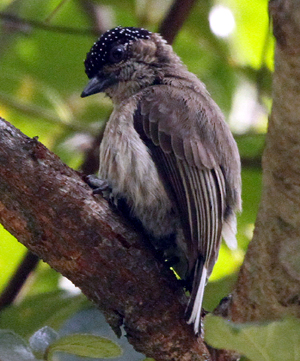 Tody Flycatcher, a Roadside Hawk soaring overhead, and a female Bar-crested Antshrike (near endemic), Black-and-white Seedeater, a family of Red-faced Spinetails and an endemic Grayish Piculet (Photo: Steve Bird) that showed very well for us! Steve spotted a Common Potoo perched on a broken tree just on the edge of an open area. We watched and photographed it for quite a while and at one point it lifted up to stretch and change position revealing a small chick keeping warm and dry underneath! Fabulous! Continuing on we found the male Bar-crested Antshrike, Blue-necked Tanager, a Golden-olive Woodpecker perched on a dead tree, and a Tennessee Warbler. A flock of at least fifteen Golden-plumed Parakeets flew over chasing a Roadside Hawk. We stopped for a few minutes in one spot which presented an Acadian Flycatcher, unbelievably three more Grayish, a female Red-headed Barbet, Black-and-White Warbler, Tropical Parula, and Northern Waterthrush. We made our way back out to the waiting van and while enjoying a snack we added Squirrel Cuckoo, Black-winged Saltator, and Ruddy Ground Dove.
Tody Flycatcher, a Roadside Hawk soaring overhead, and a female Bar-crested Antshrike (near endemic), Black-and-white Seedeater, a family of Red-faced Spinetails and an endemic Grayish Piculet (Photo: Steve Bird) that showed very well for us! Steve spotted a Common Potoo perched on a broken tree just on the edge of an open area. We watched and photographed it for quite a while and at one point it lifted up to stretch and change position revealing a small chick keeping warm and dry underneath! Fabulous! Continuing on we found the male Bar-crested Antshrike, Blue-necked Tanager, a Golden-olive Woodpecker perched on a dead tree, and a Tennessee Warbler. A flock of at least fifteen Golden-plumed Parakeets flew over chasing a Roadside Hawk. We stopped for a few minutes in one spot which presented an Acadian Flycatcher, unbelievably three more Grayish, a female Red-headed Barbet, Black-and-White Warbler, Tropical Parula, and Northern Waterthrush. We made our way back out to the waiting van and while enjoying a snack we added Squirrel Cuckoo, Black-winged Saltator, and Ruddy Ground Dove.
We left Manizales and crossed the Cauca Valley en-route to Jardin in the western Andes. We drove along the raging, Cauca River and for the first time, witnessed the flooding that had been occurring over the past several weeks. A roadside stop for lunch yielded two perched Spectacled Parrotlets as well as Red-crowned Woodpecker, Streak-headed Woodcreeper, and Smooth-billed Ani. There were White-collared and Chestnut-collared Swifts flying around as well as a few Southern Rough-winged Swallows on a wire. A last check of the area before departing produced Yellow-bellied Seedeater, Streaked Flycatcher, and the ‘Chivi’ race of Red-eyed Vireo. The afternoon was spent on the road and at another stop we got Steely-vented Hummingbird, a female Black-throated Mango, better views of another ‘Chivi’ Vireo, and very quick views of the endemic Apical Flycatcher. Another stop at a gravel pit along the river found us Ochre-bellied Flycatcher, Greenish Elaenia, Yellow-olive Flycatcher, and a Lesser Nighthawk perched on a tree branch in the sun. A Black-throated Mango had built a nest on a metal structure right in the middle of the gravel operation and as we watched a Ruddy Ground Dove perched nearby. Late in the afternoon we arrived at the charming town of Jardin. Our friend Jose was there to greet us and a festival of the Virgin Mary was in progress. We enjoyed dinner in the town square complete with fireworks and performing horses! Amazingly, the lights that lit the square and the cathedral at one end attracted thousands of moths which caught our attention as we made our way back to the hotel.
Day 10 - December 6
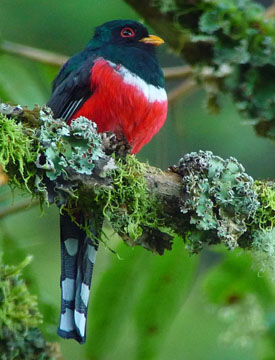 The church bells of Jardin rang repeatedly overnight and then robustly at 4:45 AM marking the beginning of a procession to the church. No worries for us as we were up and out to get to our birding destination, Altos Ventanas Road. It was a clear, crisp morning and daylight revealed our stunning surroundings. Today was a day to remember as we encountered multiple landslides making for a real adventure getting to our birding spots. Our four-wheel drive jeeps were able to negotiate the road bringing us up as far as a trout farm where we had breakfast. As breakfast was being prepared, we saw Blue-winged Mountain Tanagers, a nice perched Streak-throated Bush Tyrant and a Slaty-backed Chat Tyrant and as we ate a group of Mountain Caciques flew into a nearby tree. We started our walk up the road past the fish farm and over the first landslide which was threatening the farm itself. A Masked Trogon (Photo: Gina Nichol) posed in a tree above and just beyond the slide we had a female Barred Becard, Black-capped Tyrannulet, and some quickly disappearing Andean Siskins. Not far ahead, we walked over another landslide noting an abandoned bus on the other side. This area offered good views of a Streaked Tuftedcheek and a Smoke-colored Pewee. There were several Collared Incas around, Russet-crowned Warbler, Blue-and-Black Tanager, and Beryl-spangled Tanager. Further on, our first three endemic Yellow-eared Parrots flew over and disappeared over the hill. This was where we needed to go if we had any chance of getting better views. The next landslide required us to cut through the forest, not a major problem as the local ranger had cut a relatively easy trail around it for us. But the next landslide was much larger and the only way around was another trail cut through the forest. Our man cut the trail and the steps allowing a rather steep, challenging climb up the hillside but we all prevailed no doubt thinking “How were we going to get down?”. The climb was soon forgotten as we got back to birding with White-throated Tyrannulet, Cinnamon Flycatcher, Streak-throated Bush-Tyrant, Pale-edged Flycatcher, and a no binoculars needed view of Rufous-headed Pygmy Tyrant. Two Crimson-mantled Woodpeckers showed well and we picked up Hooded Mountain Tanager and Blue-capped Tanager. A mixed flock offered Golden-hooded Tanager, Gray-headed Bush Tanager, Pearled Treerunner, Slaty Brush Finch, and Lacrimose Mountain Tanager. We reached the official reserve for the Yellow-eared Parrots and enjoyed a
The church bells of Jardin rang repeatedly overnight and then robustly at 4:45 AM marking the beginning of a procession to the church. No worries for us as we were up and out to get to our birding destination, Altos Ventanas Road. It was a clear, crisp morning and daylight revealed our stunning surroundings. Today was a day to remember as we encountered multiple landslides making for a real adventure getting to our birding spots. Our four-wheel drive jeeps were able to negotiate the road bringing us up as far as a trout farm where we had breakfast. As breakfast was being prepared, we saw Blue-winged Mountain Tanagers, a nice perched Streak-throated Bush Tyrant and a Slaty-backed Chat Tyrant and as we ate a group of Mountain Caciques flew into a nearby tree. We started our walk up the road past the fish farm and over the first landslide which was threatening the farm itself. A Masked Trogon (Photo: Gina Nichol) posed in a tree above and just beyond the slide we had a female Barred Becard, Black-capped Tyrannulet, and some quickly disappearing Andean Siskins. Not far ahead, we walked over another landslide noting an abandoned bus on the other side. This area offered good views of a Streaked Tuftedcheek and a Smoke-colored Pewee. There were several Collared Incas around, Russet-crowned Warbler, Blue-and-Black Tanager, and Beryl-spangled Tanager. Further on, our first three endemic Yellow-eared Parrots flew over and disappeared over the hill. This was where we needed to go if we had any chance of getting better views. The next landslide required us to cut through the forest, not a major problem as the local ranger had cut a relatively easy trail around it for us. But the next landslide was much larger and the only way around was another trail cut through the forest. Our man cut the trail and the steps allowing a rather steep, challenging climb up the hillside but we all prevailed no doubt thinking “How were we going to get down?”. The climb was soon forgotten as we got back to birding with White-throated Tyrannulet, Cinnamon Flycatcher, Streak-throated Bush-Tyrant, Pale-edged Flycatcher, and a no binoculars needed view of Rufous-headed Pygmy Tyrant. Two Crimson-mantled Woodpeckers showed well and we picked up Hooded Mountain Tanager and Blue-capped Tanager. A mixed flock offered Golden-hooded Tanager, Gray-headed Bush Tanager, Pearled Treerunner, Slaty Brush Finch, and Lacrimose Mountain Tanager. We reached the official reserve for the Yellow-eared Parrots and enjoyed a 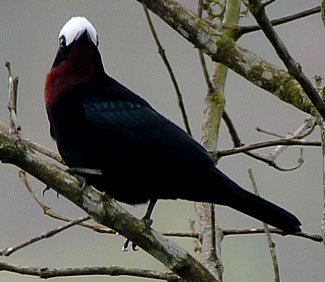 much needed rest while watching hummingbird feeders which had Collared Inca, Tourmaline Sunangel, and Buff-tailed Coronet. In the meantime, our trail cutter had gone all the way back down to the jeeps to retrieve our lunch and carried it all the way back up to us! Our entertainment while we waited was a confiding flock of White-capped Tanagers (Photo: Gina Nichol) which came in close allowing scope views and photos. There were more Yellow-eared Parrots around allowing only flight views. After lunch, we worked our way back down starting with a feeding flock along the road in front of us. It included Superciliaried Hemispingus, Golden-crowned Tanager, Sharpe’s Wren and a stunning Barred Fruiteater. Also seen were Mountain Velvetbreast, Rufous Spinetail, and a Sword-billed Hummingbird. When we reached the dreaded, steep forest path, the man had cut walking sticks for us which we could not have done without. We slowly descended and returned safely with quite an adventure to tell. As we continued down, a Golden-headed Quetzal was seen as well as four more fly over Yellow-eared Parrots for a total of 10 for the day. The Black Phoebe at the fish farm got little attention and we headed back to Jardin for another festive night in town.
much needed rest while watching hummingbird feeders which had Collared Inca, Tourmaline Sunangel, and Buff-tailed Coronet. In the meantime, our trail cutter had gone all the way back down to the jeeps to retrieve our lunch and carried it all the way back up to us! Our entertainment while we waited was a confiding flock of White-capped Tanagers (Photo: Gina Nichol) which came in close allowing scope views and photos. There were more Yellow-eared Parrots around allowing only flight views. After lunch, we worked our way back down starting with a feeding flock along the road in front of us. It included Superciliaried Hemispingus, Golden-crowned Tanager, Sharpe’s Wren and a stunning Barred Fruiteater. Also seen were Mountain Velvetbreast, Rufous Spinetail, and a Sword-billed Hummingbird. When we reached the dreaded, steep forest path, the man had cut walking sticks for us which we could not have done without. We slowly descended and returned safely with quite an adventure to tell. As we continued down, a Golden-headed Quetzal was seen as well as four more fly over Yellow-eared Parrots for a total of 10 for the day. The Black Phoebe at the fish farm got little attention and we headed back to Jardin for another festive night in town.
Day 11 - December 7
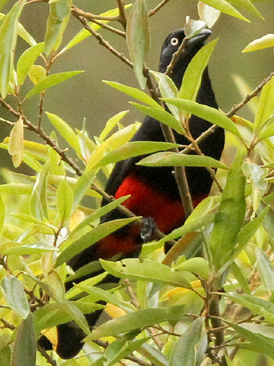 The next morning we birded around Jardin driving back toward the mountains. A pair of Subtropical Caciques by the side of the road required a quick stop before getting to our birding spot near a stream that passed under the road. There were a few Russet-backed Oropendolas around and some tending to their sack-like nests hanging from the Eucalyptus trees. A White-capped Dipper was seen on the river and we added Yellow-throated Brush Finch and Slate-throated Redstart. A flying raptor eventually came closer and landed on the trees up the mountain. We located it and identified it as a White-tailed Hawk.
The next morning we birded around Jardin driving back toward the mountains. A pair of Subtropical Caciques by the side of the road required a quick stop before getting to our birding spot near a stream that passed under the road. There were a few Russet-backed Oropendolas around and some tending to their sack-like nests hanging from the Eucalyptus trees. A White-capped Dipper was seen on the river and we added Yellow-throated Brush Finch and Slate-throated Redstart. A flying raptor eventually came closer and landed on the trees up the mountain. We located it and identified it as a White-tailed Hawk.
After a field breakfast, we birded the road and found an Andean Solitaire and a Yellow-backed Oriole. All at once Steve shouted “Red-bellied Grackle!” (Photo: Steve Bird) as eight birds arrived in a fruiting tree and gave a good, but quick show. When the grackles disappeared we moved down the road in their direction noting White-collared Swifts overhead as well as adding Golden-olive Woodpecker and getting better views of the Yellow-backed Oriole.
We moved on to another site on the other side of Jardin where we picked up Flame-rumped Tanager, Blue-gray Tanager, and Red-crowned Woodpecker. Andy saw a male Andean Cock-of-the-rock fly above the hillside and disappear into a dark leaved tree and try as we might, the bird was not to be seen again. It started to rain so after a while, we headed back to town, packed up and departed the charming Jardin. We made another stop at the gravel pit where the Black-throated Mango was still on its nest. Here we picked up Tropical Gnatcatcher, Cinereous Becard, Streak-headed Woodcreeper, a Cattle Tyrant tending to a horse, Yellow Warblers, Amazon Kingfisher, and a Spotted Sandpiper. We had nice views of Vermilion Flycatcher which 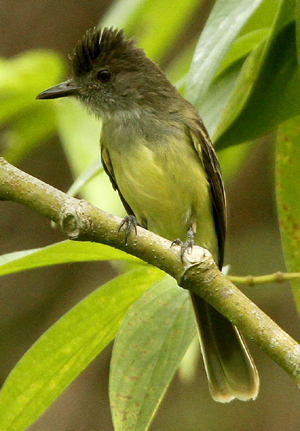 offered a bright contrast to the Mouse-colored Tyrannulet that was seen. Our lunch was taken at a roadside restaurant where a large Green Iguana was seen on the fence of an animal enclosure. A Southern Beardless Tyrannulet was seen here in the trees above the car park. After lunch, we revisited one of our spots for the endemic Apical Flycatcher (Photo: Steve Bird) which this time showed very well for us. We also saw Black-striped Sparrow, Bar-crested Antshrike, Squirrel Cuckoo, Streaked Flycatcher, a very close and showy Grayish Piculet found by Mick, and Scrub Tanager. We then drove on to Medellín for the night enjoying the incredible exhibition of lights for holiday festivities as we navigated the city traffic.
offered a bright contrast to the Mouse-colored Tyrannulet that was seen. Our lunch was taken at a roadside restaurant where a large Green Iguana was seen on the fence of an animal enclosure. A Southern Beardless Tyrannulet was seen here in the trees above the car park. After lunch, we revisited one of our spots for the endemic Apical Flycatcher (Photo: Steve Bird) which this time showed very well for us. We also saw Black-striped Sparrow, Bar-crested Antshrike, Squirrel Cuckoo, Streaked Flycatcher, a very close and showy Grayish Piculet found by Mick, and Scrub Tanager. We then drove on to Medellín for the night enjoying the incredible exhibition of lights for holiday festivities as we navigated the city traffic.
Day 12 - December 8
Today we headed toward Rio Claro on the eastern slope of the central Andes. Our breakfast stop was a great restaurant overlooking a valley with an active fruit feeder which attracted tanagers, particularly Thick-billed Euphonias. The trees above held Yellow-bellied Elaenia and Bay-breasted Warbler and there were a couple of Swallow Tanagers on the ground below the feeder. After breakfast, a Brown-crested Flycatcher showed well in the car park after which we made our way to a very birdy road adding Rusty-margined Flycatcher, Lemon-rumped Tanager, and Piratic Flycatcher along the way. An interesting looking flycatcher posing atop a small tree turned out to be just another Acadian and the birding here just got better and better as we walked down the hillside. There were so many birds it was difficult to know where to look sometimes as we ticked Buff-throated Saltator, Red-crowned Woodpecker, Rufous-tailed Hummingbird, Yellow-tufted Dacnis (likely to be a split and become a near endemic) , Streaked Saltator, Blackpoll Warbler, Southern Rough-winged Swallow, and Common Tody Flycatcher. A large group of White-collared Swifts swirled overhead and on the ground we had Yellow-bellied Seedeater., while the trees and bushes held Bay Wren, and Yellow-crowned Tyrannulets showing their yellow crowns. A bare tree held two 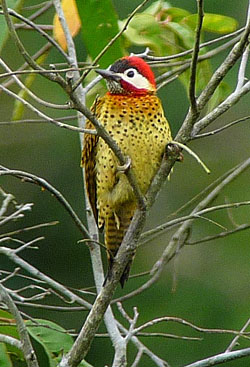 Beautiful Woodpeckers and we enjoyed excellent views of this endemic plus a cracking Spot-breasted Woodpecker (Photo: Gina Nichol) which flew into the same tree. There was also Cinnamon Becard, Bran-colored Flycatcher, Swallow Tanagers, Plain-colored Tanagers, and four endemic White-mantled Barbets, seen very well and photographed! A Long-billed Starthroat was spotted feeding on a red flower; there were three Rose-breasted Grosbeaks, Slaty-capped Flycatcher, Purple-crowned Fairy, Giant Cowbird, two Yellow-tailed Orioles, three Masked Tityras in the distance, Pale-breasted Thrush, Buff-rumped Warbler, Rufous-tailed Jacamar, and a pair of showy Olivaceous Piculets. Birding continued with several Golden-faced Tyrannulets, a gorgeous male Western Striped Manakin, Pacific Antwren, American Redstart, Sooty-headed Tyrannulet, Spectacled Parrotlets, Cinereous Becard, and Red-rumped Woodpecker (a Choco endemic). What a great morning!
Beautiful Woodpeckers and we enjoyed excellent views of this endemic plus a cracking Spot-breasted Woodpecker (Photo: Gina Nichol) which flew into the same tree. There was also Cinnamon Becard, Bran-colored Flycatcher, Swallow Tanagers, Plain-colored Tanagers, and four endemic White-mantled Barbets, seen very well and photographed! A Long-billed Starthroat was spotted feeding on a red flower; there were three Rose-breasted Grosbeaks, Slaty-capped Flycatcher, Purple-crowned Fairy, Giant Cowbird, two Yellow-tailed Orioles, three Masked Tityras in the distance, Pale-breasted Thrush, Buff-rumped Warbler, Rufous-tailed Jacamar, and a pair of showy Olivaceous Piculets. Birding continued with several Golden-faced Tyrannulets, a gorgeous male Western Striped Manakin, Pacific Antwren, American Redstart, Sooty-headed Tyrannulet, Spectacled Parrotlets, Cinereous Becard, and Red-rumped Woodpecker (a Choco endemic). What a great morning!
After an excellent lunch we set off for Rio Claro where we arrived in the afternoon and checked into our rooms. In the last hours of daylight we walked the road through the reserve adding Chestnut-backed Antbird, Cinnamon Woodpecker, and Fulvous-vented Euphonias going into grass nests in a bamboo, Great Crested Flycatcher, Golden-hooded Tanager, Orange-chinned Parakeets, two very nice Barred Puffbirds, and more White-mantled Barbets!
Day 13 - December 9
This morning after breakfast we set off for an area leading up to Cueva del Condor, an Oilbird cave on the eastern slope of the central Andes. As we arrived in the car park, some Silvery-brown Bare-faced Tamarins were spotted in the trees across the road. The monkeys quickly disappeared but some Collared Aracaris flew by and a One-colored Becard caught our attention. We walked through some farm fields and past a tree which held Yellow-rumped Caciques with their nests. Some Giant Cowbirds were around as was Piratic Flycatcher and some White-thighed Swallows which showed their white thighs while perched on some power lines. As we made our way 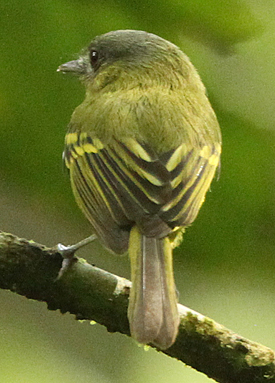 toward the forest, a Gray-lined Hawk (Gray Hawk) was seen perched on a distant tree and some Band-backed Wrens worked a bromeliad on a bare tree. We walked up a stream through the forest and into a clearing where a couple of Blue-headed Parrots were perched on a dead tree. A rarely seen Blue Cotinga was seen but disappeared quickly before all the group got onto it. A “tree of life” and the surrounding area presented a variety of birds including Green Honeycreeper, Black-headed Tody Flycatcher, Purple Honeycreeper, female Violet-crowned Woodnymph, Yellow-tufted Dacnis, male and female Blue Dacnis, Golden-hooded Tanager, Yellow-backed Tanager, Swallow Tanager, Purple-crowned Fairy, Sooty-headed Tyrannulet, Black-chested Jay, Crested Oropendola, and White-shouldered Tanager.
toward the forest, a Gray-lined Hawk (Gray Hawk) was seen perched on a distant tree and some Band-backed Wrens worked a bromeliad on a bare tree. We walked up a stream through the forest and into a clearing where a couple of Blue-headed Parrots were perched on a dead tree. A rarely seen Blue Cotinga was seen but disappeared quickly before all the group got onto it. A “tree of life” and the surrounding area presented a variety of birds including Green Honeycreeper, Black-headed Tody Flycatcher, Purple Honeycreeper, female Violet-crowned Woodnymph, Yellow-tufted Dacnis, male and female Blue Dacnis, Golden-hooded Tanager, Yellow-backed Tanager, Swallow Tanager, Purple-crowned Fairy, Sooty-headed Tyrannulet, Black-chested Jay, Crested Oropendola, and White-shouldered Tanager.
Diego heard a call from across the stream and we went over to investigate. In the forest, we were treated to great views of some showy Antioquia Bristle Tyrants (Photo: Steve Bird), a very restricted range endemic. The same area held White-bearded and Blue-crowned Manakin, Bright-rumped Attila, Plain Xenops, Black-bellied Wren, Cocoa Woodcreeper, several Slaty-winged Foliage-Gleaners, and Red-rumped Woodpecker.
As we entered the cave, a Rufous Motmot flew out and we spent some time trying to see the Oilbirds in the dark recesses. Gina trained the scope on the birds and with the help of a light we ended up with fair views of these secretive, nocturnal birds. We walked up a trail above the cave and found Olivaceous Woodcreeper, White-breasted Wood Wren, Acadian Flycatcher, and Plain-brown Woodcreeper. On the way out, we saw more Antioquia Bristle Tyrants and a Lesser Greenlet (a first in Colombia for Diego!). Back at the van, we found a Lesser Swallow-tailed Swift nesting on the building and Steve spotted a male Blue Cotinga in a bare tree on the hillside on the other side of the road.
After lunch, we departed for Victoria. Along the way we saw several birds from the bus including Gray-breasted Martin, Wattled Jacana, Ringed Kingfisher, and White-winged Swallows as we crossed the Magdalena River. Our last stop of the day was on a road that ran between some farm fields. Groove-billed Anis had now replaced the Smooth-billed, and in the fields were Red-breasted Blackbirds. A Capped Heron flew by in the distance and American Kestrels were perched on the power lines. Noisy Yellow-crowned Parrots flew around and a Velvet-fronted Euphonia was found in a close tree at the very end of the day. We were pleased to add this to our growing list of endemics. We arrived in Victoria where the town square was decorated with lighted features for Christmas. After dinner in town, we retired resting up for our last day in central Colombia.
Day 14 - December 10
This morning we arrived early at the entrance road to the Victoria reserve which had several fruiting trees and was very birdy. Species seen included Blue-black Grosbeak, Golden-crowned Flycatcher, Pale-breasted Thrush, Green Honeycreeper, Summer Tanager, several male Golden-headed Manakins, Swainson’s Thrush, and Baltimore Oriole. We walked the road into the forest and found Streak-headed Woodcreeper, Ochre-bellied Flycatcher, Scrub Greenlet, and Yellow-bellied Elaenia. Our first stunning male Sooty Ant-tanager showed well (another endemic!) and the near endemic Rufous-naped Greenlet was seen. Black-and-white Warbler turned up, as did Stripe-throated Hermit. A Little Tinamou flushed from below a bank and at the same time Diego shouted, “White-bibbed Manakin!” Pleased with this we continued on adding Plain Xenops, another Golden-headed Manakin, and Red-eyed Vireo. A trail into the forest yielded Golden-rumped Euphonia, White-breasted Wood Wren, Red-rumped Woodpecker, a Beautiful Woodpecker, Rufous-capped Warbler, and Olivaceous Piculet but the Western Slaty Antshrike that was calling did not show. A group of a dozen or so Scarlet-fronted Parakeets flew over and a close group of Short-tailed Swifts were seen.
 We headed out of Victoria toward Bogota stopping for lunch along the road we had birded last night. The American Kestrels were flying around and Roadside Hawk, Short-tailed Hawk, and Northern Caracara were seen. Some roadside trees yielded Yellow Warbler and Tropical Gnatcatcher and as we finished our picnic lunch, a Lesser Yellow-headed Vulture coursed low over the fields offering great views.
We headed out of Victoria toward Bogota stopping for lunch along the road we had birded last night. The American Kestrels were flying around and Roadside Hawk, Short-tailed Hawk, and Northern Caracara were seen. Some roadside trees yielded Yellow Warbler and Tropical Gnatcatcher and as we finished our picnic lunch, a Lesser Yellow-headed Vulture coursed low over the fields offering great views.
Outside Bogota we stopped at a bird-filled garden with several Hummingbird feeders and literally hundreds of birds. A quick count revealed at least 200 hummers buzzing around the feeders and perhaps 100 more in the surrounding trees and gardens. Most numerous was the endemic Indigo-capped Hummingbird (Photo: Gina Nichol) and there were Black-throated Mango, Rufous-tailed Hummingbird, Gorgeted Woodstar, White-bellied Woodstar, White-vented Plumeleteer, White-necked Jacobin, Green Hermit, Sparkling Violetear, and Violet-crowned Woodnymph. It was quite a spectacle and a fantastic way to finish up the main tour! We continued back to Bogota and enjoyed our last dinner with our good friend and excellent guide Diego.
SANTA MARTA TOUR: 11 December – 15 December 2010
LEADERS: Waly Naranjo, Gina Nichol and Steve Bird
Day 15 - December 11
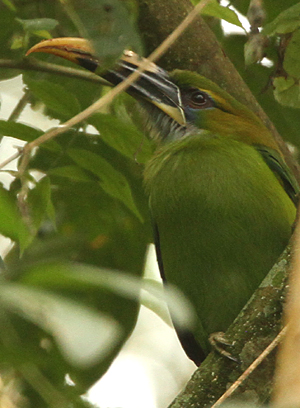 We said goodbye to Diego this morning and boarded an early flight to Santa Marta, where our guide Waly was waiting. We loaded our three 4x4 jeeps and headed into the mountains stopping for a tasty field breakfast before setting off on a short trail. During breakfast, a King Vulture soared overhead – our first of the trip! A juvenile Broad-winged Hawk was also seen as we set off along a hillside trail. Other birds seen here included Ochre-bellied Flycatcher, Ferruginous Pygmy Owl, Pale-eyed Pygmy Tyrant, Yellow Warbler, Buff-throated Saltator, Thick-billed Euphonia, Southern Beardless Tyrannulet, and Long-billed Gnatwren. Some calls from up a hillside caught our attention as we searched for the culprit. The prize for our patience was a pair of endemic Black-backed Antshrikes that finally showed well. We moved up the hill and picked up Streaked Saltator, Broad-winged Hawk, White-collared Swift, Black-chested Jay, Golden-olive Woodpecker, Yellow-tailed Oriole, Rufous-capped Warbler, and a very nice look at Yellow-billed Toucanet (Photo: Steve Bird), a nice find this low down. We were soon ticking more Santa Marta endemics with Santa Marta Brush Finch and White-lored Warbler, but nearby an Orange-billed Nightingale Thrush remained elusive.
We said goodbye to Diego this morning and boarded an early flight to Santa Marta, where our guide Waly was waiting. We loaded our three 4x4 jeeps and headed into the mountains stopping for a tasty field breakfast before setting off on a short trail. During breakfast, a King Vulture soared overhead – our first of the trip! A juvenile Broad-winged Hawk was also seen as we set off along a hillside trail. Other birds seen here included Ochre-bellied Flycatcher, Ferruginous Pygmy Owl, Pale-eyed Pygmy Tyrant, Yellow Warbler, Buff-throated Saltator, Thick-billed Euphonia, Southern Beardless Tyrannulet, and Long-billed Gnatwren. Some calls from up a hillside caught our attention as we searched for the culprit. The prize for our patience was a pair of endemic Black-backed Antshrikes that finally showed well. We moved up the hill and picked up Streaked Saltator, Broad-winged Hawk, White-collared Swift, Black-chested Jay, Golden-olive Woodpecker, Yellow-tailed Oriole, Rufous-capped Warbler, and a very nice look at Yellow-billed Toucanet (Photo: Steve Bird), a nice find this low down. We were soon ticking more Santa Marta endemics with Santa Marta Brush Finch and White-lored Warbler, but nearby an Orange-billed Nightingale Thrush remained elusive.
We took our lunch at our favorite roadside tienda hoping for views of a Blossomcrown but no luck this time (but we did find this beauty later in the trip!). We were well entertained however with the eight or so Blue-naped Chlorophonias coming to the banana feeder. Some Green Violetears and a Violet-crowned Woodnymph visited the flowers in front of us and a flock of Pale-vented Pigeons flew over. Brian found a nice Black-headed Tanager that showed well just before we boarded the jeeps to continue up the bumpy road to the lodge. We arrived at the lodge and settled in for our two night stay.
Day 16 - December 12
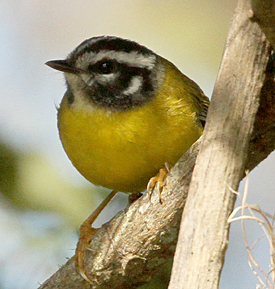 This morning we had a pre-dawn coffee and departed for San Lorenzo Ridge. Along the way the first vehicle flushed a Band-winged Nightjar. We stopped and checked for Santa Marta Screech-Owl which came in to our playback but remained invisible in the trees despite our diligent search. We continued up the road as daylight fell and soon found an endemic Rusty-headed Spinetail in the roadside thicket. A Rufous Antpitta was calling from down the hill and Mick sat quietly in the bamboo and managed to get a photo. A Brown-rumped Tapaculo was calling as well but did not show. Continuing on, we had Tyrian Metaltail and White-sided Flowerpiercer. The birding was slow but the scenery incredible with sparkling blue skies and mountains on one side and view to Santa Marta on the other. Endemic Yellow-crowned Whitestarts were in abundance and we had numerous good views of Santa Marta Brush Finch, another endemic. After breakfast, we continued up the hill ticking Cinnamon Flycatcher (the Santa Marta race), White-throated Tyrannulet, and a Strong-billed Woodcreeper that put on a show for us as it foraged tearing apart some bromeliads on a tree trunk. Just ahead three super Santa Marta Warblers (Photo: Steve Bird) put on a show of their own flying back and forth across the track allowing many photos. The altitude now was 2470 meters and we turned back to walk down the track adding White-sided Flowerpiercer, Yellow-legged Thrush, and Yellow-bellied Chat Tyrant. Santa Marta Antpitta proved ever elusive and called but did not show. As we were about to leave a small flock appeared offering Santa Marta Bush Tyrant a good endemic, lots of White-throated Tyrannulets, Santa Marta Brush Finch, Golden-breasted Fruiteater, and Santa Marta Mountain Tanager. Sweet!
This morning we had a pre-dawn coffee and departed for San Lorenzo Ridge. Along the way the first vehicle flushed a Band-winged Nightjar. We stopped and checked for Santa Marta Screech-Owl which came in to our playback but remained invisible in the trees despite our diligent search. We continued up the road as daylight fell and soon found an endemic Rusty-headed Spinetail in the roadside thicket. A Rufous Antpitta was calling from down the hill and Mick sat quietly in the bamboo and managed to get a photo. A Brown-rumped Tapaculo was calling as well but did not show. Continuing on, we had Tyrian Metaltail and White-sided Flowerpiercer. The birding was slow but the scenery incredible with sparkling blue skies and mountains on one side and view to Santa Marta on the other. Endemic Yellow-crowned Whitestarts were in abundance and we had numerous good views of Santa Marta Brush Finch, another endemic. After breakfast, we continued up the hill ticking Cinnamon Flycatcher (the Santa Marta race), White-throated Tyrannulet, and a Strong-billed Woodcreeper that put on a show for us as it foraged tearing apart some bromeliads on a tree trunk. Just ahead three super Santa Marta Warblers (Photo: Steve Bird) put on a show of their own flying back and forth across the track allowing many photos. The altitude now was 2470 meters and we turned back to walk down the track adding White-sided Flowerpiercer, Yellow-legged Thrush, and Yellow-bellied Chat Tyrant. Santa Marta Antpitta proved ever elusive and called but did not show. As we were about to leave a small flock appeared offering Santa Marta Bush Tyrant a good endemic, lots of White-throated Tyrannulets, Santa Marta Brush Finch, Golden-breasted Fruiteater, and Santa Marta Mountain Tanager. Sweet!
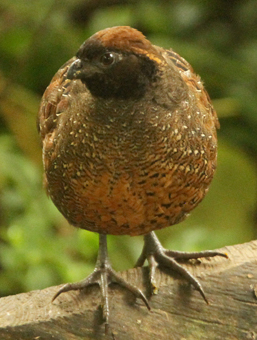 Back at the lodge, the feeders were buzzing and the surrounding area offered some good birds. Both male and female Golden-breasted Fruiteaters were seen and the feeders offered up close and personal views of Blue-naped Chlorophonia, White-tailed Starfrontlet, Brown Violetear, Sparkling Violetear, Green Violetear, Violet-crowned Woodnymph, and a female Santa Marta Woodstar. A male Lazuline Sabrewing was a very good bird to see although most of the time it was perched in shadow. Some Red-billed Parrots flew over, too high to really see any features. We kept a vigil on the kitchen compost pile which eventually yielded Colombian Brush Finch (a recent split from Stripe-headed) and four Black-fronted Wood Quail (Photo: Steve Bird). Crested Oropendolas were seen and a Rufous-headed Spinetail showed well. We checked an area for Santa Marta Antpitta but no luck. Blue-capped Tanager and Streak-capped Spinetail were our consolation.
Back at the lodge, the feeders were buzzing and the surrounding area offered some good birds. Both male and female Golden-breasted Fruiteaters were seen and the feeders offered up close and personal views of Blue-naped Chlorophonia, White-tailed Starfrontlet, Brown Violetear, Sparkling Violetear, Green Violetear, Violet-crowned Woodnymph, and a female Santa Marta Woodstar. A male Lazuline Sabrewing was a very good bird to see although most of the time it was perched in shadow. Some Red-billed Parrots flew over, too high to really see any features. We kept a vigil on the kitchen compost pile which eventually yielded Colombian Brush Finch (a recent split from Stripe-headed) and four Black-fronted Wood Quail (Photo: Steve Bird). Crested Oropendolas were seen and a Rufous-headed Spinetail showed well. We checked an area for Santa Marta Antpitta but no luck. Blue-capped Tanager and Streak-capped Spinetail were our consolation.
Day 17 - December 13
Once again we traveled up San Lorenzo Ridge in the morning. A White-lored Warbler showed well and we spent some time watching the antics of a Great Thrush and a Cocoa Woodcreeper feeding on insects attracted to a light pole in the forest. Santa Marta Mountain Tanager was seen well. Golden-breasted Fruiteater was seen again and a Golden-bellied Grosbeak was seen well. Our victory of the morning was good views of Brown-rumped Tapaculo which sat on an open perch in the shadows singing for a minute or so allowing most of us satisfying views.
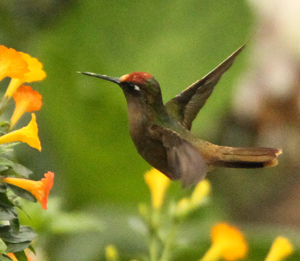 After breakfast, we bounced our way down toward Minca with birding stops that added Montane Foliage Gleaner, several Scaly-naped Parrots in a tree with some Venezuelan Red Howler Monkeys, and White-sided Flowerpiercer. At the garden at Palo Alto we had a male Santa Marta Woodstar perched atop a tall tree. There were some Crested Oropendolas and we had prolonged and amazing views of a gorgeous male Blossomcrown (Photo: Steve Bird) feeding on some flowers. Another spot yielded a pair of White-tipped Quetzals and a Santa Marta Foliage Gleaner remained elusive. Rusty-breasted Antpitta (Photo: Steve Bird) was much more cooperative eventually showing well, while further down we added Coppery Emerald, and enjoyed nice views of Golden-winged Sparrow and Streaked Saltator. We continued on to the coast and the Guajira Peninsula. A stop for fuel was quite productive adding several birds including Yellow Orioles, Killdeer and Scaled Doves.
After breakfast, we bounced our way down toward Minca with birding stops that added Montane Foliage Gleaner, several Scaly-naped Parrots in a tree with some Venezuelan Red Howler Monkeys, and White-sided Flowerpiercer. At the garden at Palo Alto we had a male Santa Marta Woodstar perched atop a tall tree. There were some Crested Oropendolas and we had prolonged and amazing views of a gorgeous male Blossomcrown (Photo: Steve Bird) feeding on some flowers. Another spot yielded a pair of White-tipped Quetzals and a Santa Marta Foliage Gleaner remained elusive. Rusty-breasted Antpitta (Photo: Steve Bird) was much more cooperative eventually showing well, while further down we added Coppery Emerald, and enjoyed nice views of Golden-winged Sparrow and Streaked Saltator. We continued on to the coast and the Guajira Peninsula. A stop for fuel was quite productive adding several birds including Yellow Orioles, Killdeer and Scaled Doves.
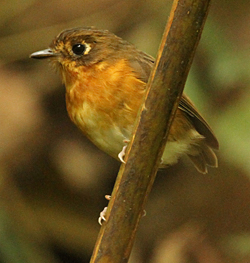 In the late afternoon, we made a quick stop in a dry scrub area – well, normally dry except for the unusual torrential rains that had deluged the area. A Russet-throated Puffbird posed on a farm fence for us. Some Rufous-vented Chachalacas were calling in the distance and a Ferruginous Pygmy Owl was seen being mobbed by a Tropical Gnatcatcher.
In the late afternoon, we made a quick stop in a dry scrub area – well, normally dry except for the unusual torrential rains that had deluged the area. A Russet-throated Puffbird posed on a farm fence for us. Some Rufous-vented Chachalacas were calling in the distance and a Ferruginous Pygmy Owl was seen being mobbed by a Tropical Gnatcatcher.
Day 18 - December 14
Before dawn, we arrived at our first birding spot in the dry scrub, now flooded with more heavy overnight rains. As we waited for daylight, a White-tailed Nightjar was seen and we ate our field breakfast in the rain overlooking the Camarones wetland. Across the open water were American Flamingos, Great Egret, Snowy Egret, Reddish Egret, Tricolored Heron, and several Roseate Spoonbills flew over. Shorebirds included Collared Plover, Semipalmated Plover, Willet, and Stilt Sandpiper and there were Laughing Gulls and a few Royal Terns seen.
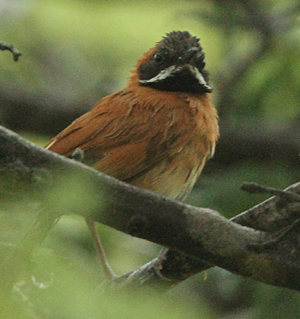 By now we were soaking wet and wishing we had wellies. There were a few Carib Grackles on the road and when the rains subsided slightly, we went into the forest. A Red-billed Emerald was seen and a Dicksissel sat out singing in the rain. There were a few Brown-throated Parakeets flying around and we were able to get on some that were perched. A stunning Vermilion Cardinal added color to the otherwise drab morning and a Bicolored Wren showed well. Some Scaled Doves on the ground were virtually ignored and a group of Trinidad Euphonias perched in a tree got away quickly. A Tropical Mockingbird was seen just before a Ferruginous Pygmy-owl flew into a nearby tree being chased by a group of very annoyed Pileated Finches. There were lots of Buffy Hummingbirds around and a Wood Stork was seen flying over. The irony of the situation was a Pied Water Tyrant in the (not so) dry zone! Next up were White-fringed Antwren and Mouse-colored Tyrannulet and a White-whiskered Spinetail (Photo: Steve Bird) offered great views and was unofficially named Colombia’s best looking Spinetail.
By now we were soaking wet and wishing we had wellies. There were a few Carib Grackles on the road and when the rains subsided slightly, we went into the forest. A Red-billed Emerald was seen and a Dicksissel sat out singing in the rain. There were a few Brown-throated Parakeets flying around and we were able to get on some that were perched. A stunning Vermilion Cardinal added color to the otherwise drab morning and a Bicolored Wren showed well. Some Scaled Doves on the ground were virtually ignored and a group of Trinidad Euphonias perched in a tree got away quickly. A Tropical Mockingbird was seen just before a Ferruginous Pygmy-owl flew into a nearby tree being chased by a group of very annoyed Pileated Finches. There were lots of Buffy Hummingbirds around and a Wood Stork was seen flying over. The irony of the situation was a Pied Water Tyrant in the (not so) dry zone! Next up were White-fringed Antwren and Mouse-colored Tyrannulet and a White-whiskered Spinetail (Photo: Steve Bird) offered great views and was unofficially named Colombia’s best looking Spinetail.
The rains got heavier so we moved out to the beach where we could get under the cover of a Tiki Hut and watch the sea. There were several Cabot’s Terns (some authorities now splitting this from Sandwich Tern) and Royal Terns, Laughing Gulls, Magnificent Frigatebirds, and squadrons of Brown Pelicans. A Skua chasing a tern caused a great deal of excitement and was later identified by photos as a second year Arctic Skua (Parasitic Jaeger) a rare visitor. As the rains let up we walked out on the beach and picked up Black-bellied Plover, Sanderling, Ruddy Turnstone, and Semipalmated Plover.
We decided to have an early lunch seeing another two adult Arctic Skuas further out at sea. By the time we finished eating the rain had let up so we walked around the immediate area adding Black Skimmer and Black-necked Stilt to our list. The nearby mudflats offered great views of Collared Plover and a Least Sandpiper. A closer look at some of the terns revealed a Gull-billed Tern amongst them.
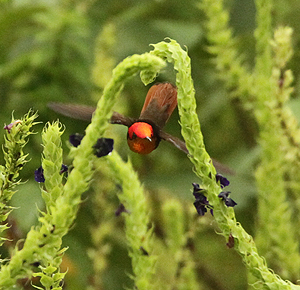 Back to the forest, there were more Buffy Hummingbirds, Pale-eyed Pygmy Tyrant, Brown-crested Flycatcher, Slender-billed Inezia, Black-crested Antshrike, and Russet-throated Puffbird. A Ruby Topaz (Photo: Steve Bird) stunned us all as it fed on some flowers, and when the light caught it right the bird appeared to just burst into flames! We then walked a narrow, flooded trail and found Northern Waterthrush, several Prothonotary Warblers, White-whiskered Spinetail, and another Pale-eyed Pygmy Tyrant. We left Camarones and made another roadside stop near Perico where we found a very out of place Wattled Guan in a tree near the road. Again there were many Prothonotary Warblers as well as Northern Scrub Flycatcher and our prize, not one, but three near endemic Chestnut Piculets! In the same tree were Glaucous Tanagers and White-fringed Antwren and on the other side of the path we had Slate-headed Tody Flycatcher, Yellow Flycatcher and Scrub Greenlet. Back toward the van, we had Caribbean/Pale-legged Hornero and took some more record shots of the out of place Guan. Late in the day, we returned to flooded Santa Marta for the night. We passed by small villages and it seemed the mornings rain coming off the mountains had caused untold flooding with many villagers now taking up residence on the main road with what possessions they could salvage, as their houses were 4 to 5 feet underwater.
Back to the forest, there were more Buffy Hummingbirds, Pale-eyed Pygmy Tyrant, Brown-crested Flycatcher, Slender-billed Inezia, Black-crested Antshrike, and Russet-throated Puffbird. A Ruby Topaz (Photo: Steve Bird) stunned us all as it fed on some flowers, and when the light caught it right the bird appeared to just burst into flames! We then walked a narrow, flooded trail and found Northern Waterthrush, several Prothonotary Warblers, White-whiskered Spinetail, and another Pale-eyed Pygmy Tyrant. We left Camarones and made another roadside stop near Perico where we found a very out of place Wattled Guan in a tree near the road. Again there were many Prothonotary Warblers as well as Northern Scrub Flycatcher and our prize, not one, but three near endemic Chestnut Piculets! In the same tree were Glaucous Tanagers and White-fringed Antwren and on the other side of the path we had Slate-headed Tody Flycatcher, Yellow Flycatcher and Scrub Greenlet. Back toward the van, we had Caribbean/Pale-legged Hornero and took some more record shots of the out of place Guan. Late in the day, we returned to flooded Santa Marta for the night. We passed by small villages and it seemed the mornings rain coming off the mountains had caused untold flooding with many villagers now taking up residence on the main road with what possessions they could salvage, as their houses were 4 to 5 feet underwater.
Day 19 - December 15
This morning we had a few hours before out flight back to Bogota so we drove out to Isla Salamanca National Park. From the road we ticked Cocoi Heron and a stop yielded good views of Bare-eyed Pigeon and Brown-throated Parakeet. The roadside ponds held many water birds including Tricolored Heron, Little Blue Heron, Snowy and Great Egret, and Great Blue Heron. A Least Sandpiper was seen and other shorebirds included Greater and Lesser Yellowlegs and Hudsonian Whimbrel. Magnificent Frigatebirds and Neotropic Cormorants were seen and one roost held at least 700 Caspian Terns (Photo: Steve Bird) ! A Least Tern was seen flying and there were numerous Black-necked Stilts and a few groups of White-cheeked Pintail.
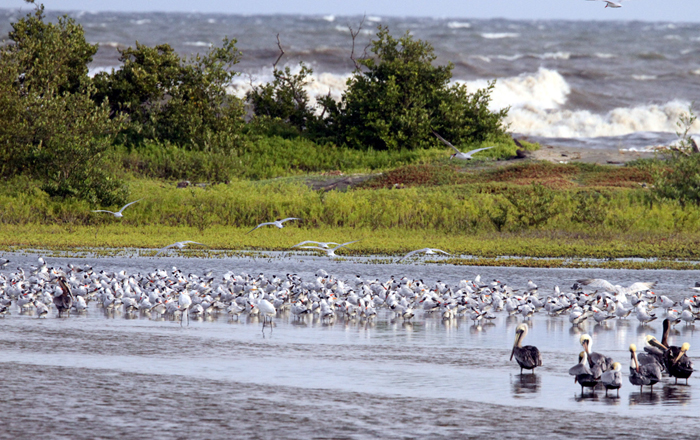
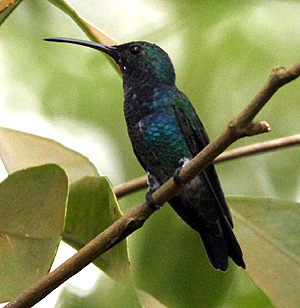 At Kangaroo Point, we had our last field breakfast and noted Spotted Sandpiper, Ringed Kingfisher, Collared Plover, Willet, Solitary Sandpiper, Semipalmated Sandpiper, Wilson’s Plover, and more Prothonotary Warblers. We moved to another part of the reserve and walked a trail beside the mangroves. In an open area we had a nice Sapphire-throated Hummingbird (Photo: Steve Bird) and from a boardwalk we had good views of two Bicolored Conebills. A Least Grebe was seen in a pond and we also had Straight-billed Woodcreeper and wonderful looks at another pair of Bicolored Wrens. Our drive back to Santa Marta was exciting to say the least as several strikes resulted in road blocks that threatened to make us miss our flight. But our fantastic driver navigated around it all and got us back to Santa Marta in plenty of time. We said goodbye to Waly at the airport and traveled on to Bogota and our connecting flights home.
At Kangaroo Point, we had our last field breakfast and noted Spotted Sandpiper, Ringed Kingfisher, Collared Plover, Willet, Solitary Sandpiper, Semipalmated Sandpiper, Wilson’s Plover, and more Prothonotary Warblers. We moved to another part of the reserve and walked a trail beside the mangroves. In an open area we had a nice Sapphire-throated Hummingbird (Photo: Steve Bird) and from a boardwalk we had good views of two Bicolored Conebills. A Least Grebe was seen in a pond and we also had Straight-billed Woodcreeper and wonderful looks at another pair of Bicolored Wrens. Our drive back to Santa Marta was exciting to say the least as several strikes resulted in road blocks that threatened to make us miss our flight. But our fantastic driver navigated around it all and got us back to Santa Marta in plenty of time. We said goodbye to Waly at the airport and traveled on to Bogota and our connecting flights home.